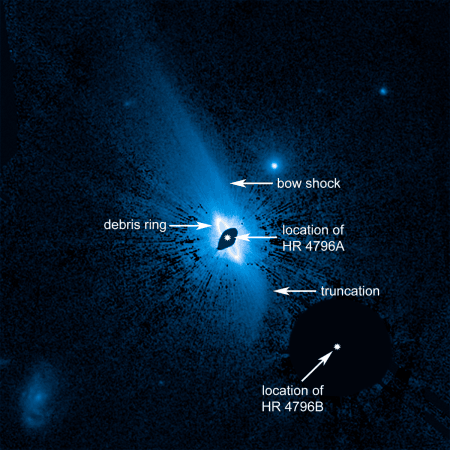
Nasa's Hubble space telescope has uncovered a new, yet-to-be studied, young star system and it looks magnificent. The star, named HR 4796A, in astronomical terms is a "young" star despite being eight million years old. In comparison, the Sun is about 4.6 billion years old.
The star has a dust disk that stretches out over 150 billion miles across, says Nasa. The dust system is made of fine particles that are likely the result of developing planets colliding with each other near the star. The dust could have then gotten dispersed over the vast region surrounding it by the pressure of starlight radiation. This system is still in its formative years of planet construction, according to Nasa and the star is about 23 times brighter than the Sun.
There is a bright, inner ring of dust already swirling around the star, possibly held in place by the gravity of a giant planet that has not been observed yet, notes the report.
The outer dust structure has been likened to a donut-shaped tube that got hit by a truck because of how it seems stubby on one side while elongated on the other even after accounting for its relative incline. Another reason for this look might be because the star itself is moving at incredible speeds through its medium, like a wave stemming out from the leading edge of a boat on still water. Another reason for this rather strange shape could be because of the gravity from a nearby red dwarf star, about 54 billion miles from HR 4796A, could be warping the dust.
"The dust distribution is a telltale sign of how dynamically interactive the inner system containing the ring is," said Glenn Schneider of the University of Arizona. He is the researcher who made use of the Space Telescope Imaging Spectrograph (STIS) on board Hubble to identify and map the dust system circling the HR 4796A. The report notes that this is possible only by Hubble's sensitive instruments.
"We cannot treat exoplanetary debris systems as simply being in isolation. Environmental effects, such as interactions with the interstellar medium and forces due to stellar companions, may have long-term implications for the evolution of such systems. The gross asymmetries of the outer dust field are telling us there are a lot of forces in play (beyond just host-star radiation pressure) that are moving the material around. We've seen effects like this in a few other systems, but here's a case where we see a bunch of things going on at once," he explained.

















